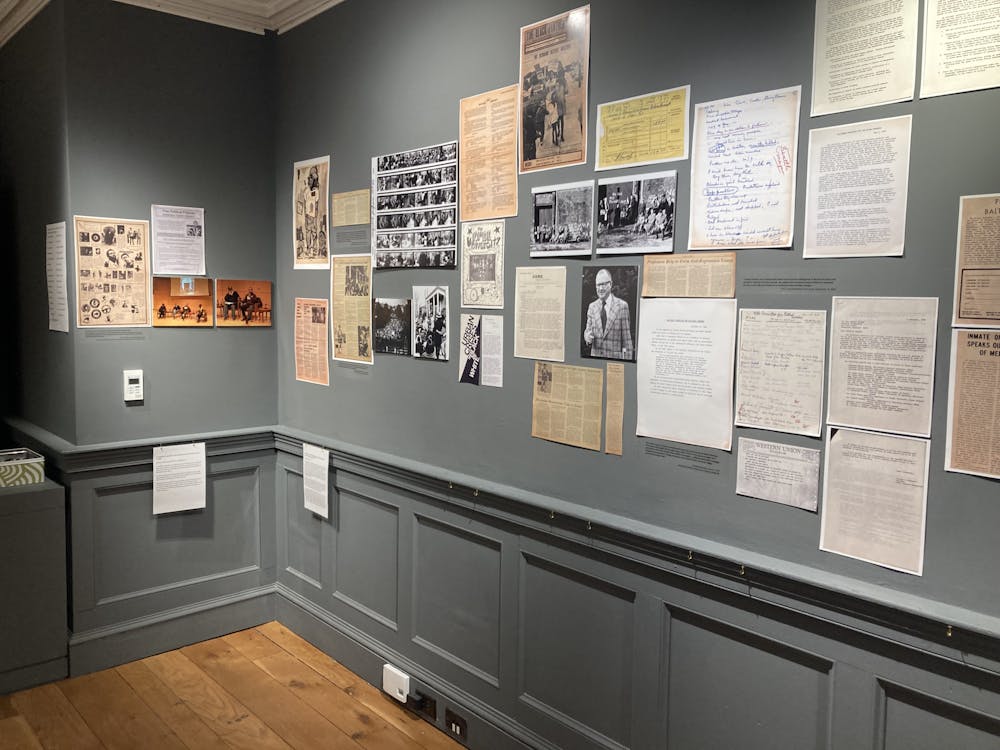FOOT LOCKER, the first American solo exhibition of French artist Thomas Teurlai, opened on March 6 in the Copycat Building on Guilford Ave., as part of Station North’s monthly ALLOVERSTREET art walk. Only in a city like Baltimore could this parking garage of a former manufacturing warehouse be turned into a site-specific contemporary art exhibition, its disrepair embraced and given new meaning.
The crux of the exhibit takes the concept of mass production, an ever-present force behind the maintenance of modern consumerism, and juxtaposes it with one person’s ability to create simply with their bare hands. The shoe stores of today are filled with the carbon copies of machine byproducts, perfect creations that glisten on shelves with the promise of 100 percent customer satisfaction.
Meanwhile, Teurlai’s ceramic reproductions of Nike Airs and Dallas Cowboys snapbacks hint at the contemporary shortcomings of the manmade ideal. Each shoe has a different point of weakness — a deformed heel on one, a gaping hole in another — that distinguishes it from the others.
“I first came across Teurlai’s work at the Palais de Tokyo in Paris last May,” Joseph Shaikewitz, the curator of FOOT LOCKER, said. “His work captivated me in its creation of a direct, corporeal relationship with the spectator, which is a major theme in my own art historical research. I also saw parallels between the local art scene and Teurlai’s interests in industry and site-specificity. I wanted to see how these two could come into play specifically in Baltimore.”
Some of the shoes and hats get no shelf life at all, as evidenced by the haphazard piles of broken ceramics under several of the hanging displays. The viewer can only imagine what the object may have looked like and mourn the exhaustive effort to achieve mechanical perfection with his bare hands.
Other aspects of the exhibition more directly utilize the physical qualities of the space, each in a particularly jarring fashion. A fan suspended from the ceiling at one end of the gallery is wired to a broken, liquid-filled bottle at the other end as well as to the light fixture above the bottle. Each time the fan sways even the slightest bit, the bottle is agitated and drips liquid onto a system of wires, causing the light fixture to flicker and dim for an unspecified amount of time.
The unpredictability of this process takes power away from the viewer — and even, perhaps, the artist himself — and gives it to unexpected atmospheric movements that only the space itself has any say in creating.
In order to transform the artspace, Shaikewitz and Teurlai maintained a less rigid relationship typical of artists and their organizers.
“The role of the curator is becoming increasingly fluid and nebulous, but I find this to be to its benefit,” Shaikewitz said. “Thomas and I each relied on one another to bring the exhibition to fruition, but we were also able to overlap at times in terms of duties that are traditionally deemed ‘artistic’ or ‘curatorial.’ With a short timeline and a fixed budget, being nimble in the process worked to our advantage.”
Meanwhile, dirty water flows from an overhead pipe into a wax paper-lined basket, which in turn is surrounded by other broken molds and a giant chunk of fresh clay. Here, the viewer can see the very beginning of an organic process, one as painstaking as it is isolated.
The sound of the water hitting the basket hints at the cacophony of a machine assembly line, an incessant percussion of sorts that echoes throughout the space with grating tonality.
“The Baltimore art scene is accessible,” Shaikewitz said. “Emerging artists have the freedom to experiment with their work, both formally and socially. Curators like myself encounter few barriers in mounting an exhibition in the area. Potential viewers are invited with open arms to experience the local art scene. If you come with an open mind and an interest in engaging with new ideas, you can get a lot out of the local arts.
“Concerts in living rooms, exhibitions in clock towers, performances in parking lots — there’s no shortage of visionary, experimental art to experience for free or practically dirt cheap,” he said.
“The Baltimore art scene may feel like an ‘added bonus’ to attending Hopkins, but if you choose to embrace all that it offers, you can be a part of something that both defines this city and can challenge your ways of thinking.”
A Hopkins senior with an Art History major and Museums & Society minor, Shaikewitz played a major role in coordinating Teurlai’s exhibit in accordance with his own academic endeavors.
“I applied for an Arts Innovation Grant last year, which allowed me to fund Teurlai’s residency and project here in Baltimore. The exhibition also served as my senior capstone for my minor in Museums & Society, and the program provided additional funds to the project. My minor has exposed me to curatorial practice in the past, and my advisor Elizabeth Rodini gave me both the resources and freedom to take Teurlai’s exhibition in my own direction,” Shaikewitz said.
After unveiling this latest art space, he reflected on his experience as a curator.
“The most gratifying aspect of the curatorial process emerges in the very beginning,” he said. “Being able to hone in on an artist whose work I fully believe in and giving them an exhibition as a platform for their practice is incredibly meaningful for me.
“Through the selection of the space, written interpretations of the artist’s work and promotion to a regional audience, the curator has the potential to truly bolster an artist’s work and career. Another thing: Art history as a discipline can at times dehumanize the artist as we spend so much of our time analyzing artworks as autonomous from the means of their creation. With curating I’m given the chance to work directly with an artist, learn from them and experience the process firsthand.”















Please note All comments are eligible for publication in The News-Letter.